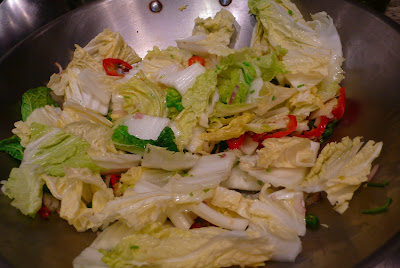 |
| Clams with Fermented Black Bean Sauce |
Friday night... The weekend is finally here!! If there is an Asian dish that most resembles a tapas snack or brings memories of boisterous fun times is this dish of Stir Fried Clams in Fermented Black Bean Paste! Cooking this dish is almost a dance as you feel the energy pouring out of you. This dish has always been a family favorite. Growing up in Guatemala, for some reason, fresh small clams were hard to come by. Hence, this dish was something we would always be looking forward to eating when we went to Miami on vacation, as a family. It would be the very first thing my dad would order and once it arrived the table it would literally be gone in exactly 2 minutes and 30 seconds. There were no words, just that easy, 'shooshing' up of the clam and its ocean nectar, paired up perfectly with chillies, black bean paste (nutty, wild taste) and scallion. Perfection in a bite! Now, as an adult, I am still very fond of this dish and find that it is perfect to have with friends and pairing up with an ice cold beer or sparkling wine. One can have it 'solo' as an appetizer or a tapas dish; or as part of the main meal, along with - you guessed it - steamed white jasmin rice! So, no matter what you are in the mood for, this plate will surely help you ease into the joy of the weekend. Enjoy! - Connie
Level: Easy to intermediate
Servings: 2
Time to cook: 30 minutes
Ingredients:
2 shallot (thin slices)
2 - 3 garlic cloves (minced)
2 tablespoons of peanut oil
1 pinch of sugar
2 - 3 thai peppers (sliced)
1 small piece of ginger (julienned)
1 tablespoon of fermented black bean paste (I love the Lee Kum Kee brand)
1/2 tablespoon of oyster sauce (Again, I recommend Lee Kum Kee - specially the premium sub-brand)
1 handful of cilantro (leaves and small stems) - cut off the large part of the stem and mince
1 lb of small clams (smaller than the little necks - though one can substitute it if necessary; in this case smaller ones work better than larger ones. In Singapore these are called 'la- las'. In Chicago, best place to find them is in Asian supermarkets like Mitsuwa in Arlington Heights)
1/2 tablespoon of cognac (I like using calvados as the apple flavor perfumes the dish. For a non-alcoholic version, substitute with either apple cider, water or chicken stock)
Preparation:
1. Start by cleaning the clams under running water and brush the shells to take away any sediments. (Note: If this is your first time cleaning clams, some of them may be slightly open but will close up as you put them under running water. If they are open and do not close up - probably they need to be discarded. Additionally, if you don't use the clams right after you purchase them, one way to store them is to put them on a plate within a bowl that has been filled up with ice cubes and salt; and put a slightly damp paper towel on top of them. The clams need to breathe, and since they are alive, they should not be stored directly on ice as they will drown)
2. Heat up your wok (high heat) and once it is hot, drop in the olive oil and the aromatics (shallot, garlic, chillies, and ginger). Stir fry for 2 - 3 minutes, until the shallots are slightly golden
3. Drop the clams into the the wok and stir for 1 minute
4. Drop into the middle of the work the fermented black bean paste and oyster sauce and stir it for another minute or two, and then sprinkle in a pinch of sugar
5. De-glace with the cognac (or apple cider, water or chicken stock) and cover for for 5 - 8 minutes (Note: Cooking time depends on the size of the clams. Cover until all the clams have opened up. If there are clams that persistently remain shut after 15 minutes, discard them)
6. Once the clams have open up, stir in the parsley and serve
Tip: Do not put salt on the clams, as they will already be salty. Also, if you use larger clams, make sure to err on the side of putting less black bean paste than more, as the clams will be more salty. Black bean paste is a very pungent and powerful ingredient. It is very easy to overpower the dish with it so if you are using it for the first time, use it more sparingly
Copyright delimilli 2011

























